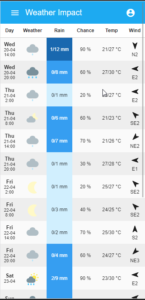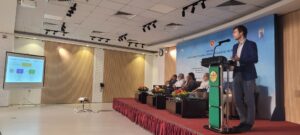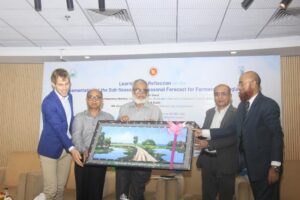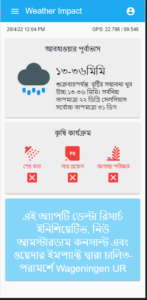Bangladesh
With a steadily increasing population of 160 million people, its low elevation and coastal location, Bangladesh is among the most vulnerable countries to climate change. Flood and droughts ravage the lowlands, while salinity intrusion, land subsidence, cyclones, and rising sea-levels endanger the population living in the Bay of Bengal. According to a report by USAID, 56% of the population lives in high climate exposure area. Simultaneously, 70% of Bangladeshis live in rural areas, among which 87% depend on agriculture. Weather affects 80% of crop-yield variability—making those farmers subject to an uncertain economic future due to variation in the monsoon onset, drought incidences, and flood occurrences. At the same time, accurate and location-specific meteorological forecasts offer great potentials for securing food production against climate-related risks. Climate change is a national threat and requires solutions that can be easily scaled to the entire country.
Project 1: Sub-seasonal to seasonal forecasts for agriculture (S2S4Agri)
Weather Impact cooperates with Wageningen Environmental Research (WEnR) and Digital Innovation for Impact to support the Department of Agricultural Extension (DAE) and Bangladesh Meteorological Department (BMD) with the implementation of sub-seasonal to seasonal (S2S) forecasts. Together we have developed the entire data stream from weather model data to agronomical advisory services. The project is part of the Agro-Meteorological Information Systems Development Project (AMISDP) which is funded by The World Bank.
S2S forecasts are weather forecasts for the next 4 weeks and provide an indication of the weather on a weekly time scale. These forecasts fall between the conventional short term forecasts (up to 10 days ahead) and monthly or seasonal forecasts and are at the forefront of the current science and not yet widely used. Weather Impact assists BMD and DAE in the development and use of these type of forecasts. The S2S timeframe contains potentially valuable information for famers. For example; will the monsoon start early or late? Are there indications for extreme rainfall? Or is there a chance on a cold wave coming?
Components of the project are an assessment of the S2S models over Bangladesh, implementation of an operational S2S at the BMD and co-development of agronomical advisory products. These farm management advisories give the farmer more time to act on weather situations and helps them in their decision making to plan, postpone or anticipate on their farming activities. The newly developed advisories will be tested and validated in the field.
The most important component of the project is to sustain the newly developed services by providing capacity building trainings. BMD and DAE officials will be trained by Weather Impact and WEnR to use the system. Furthermore, a standardized operational procedure (SOP) will be discussed and developed with both BMD and DAE. The SOP defines the roles and responsibilities of the organizations in the S2S data chain.
Official launch S2S forecasting system
As part of the S2S4Agri project, a team from Weather Impact visited Bangladesh in March 2023. For this project, a S2S (Sub-seasonal to Seasonal) forecasting system was developed, which provides weather forecasts for farmers on the scale of weeks, up to four weeks in advance. The objective of this trip was to train people from BMD (Bangladesh Meteorological Department) and DAE (Department of Agricultural Extension) to use our newly developed S2S forecasting system which was officially launched afterwards. This training week was perceived with great enthusiasm and participants learned about S2S theory, python language and forecast validation methods. Finally a workshop was hosted where employees from BMD and DAE collaborated to formulate and present their agrological advice, based on the latest forecast. To close the week, the system was officially launched during a large event that made the national television and several online journalism platforms. At the event, attendants were very positive about a development like this in their country and see great potential of S2S forecasts in other sectors.
Fig.1; Official launching event for S2S forecasting system with Bob Ammerlaan (Weather Impact) and the Honorable Secretary of Agriculture, Wahida Akter.
Learning and reflection on S2S forecasting system
The final workshop of the project took place in October 2023 in Dhaka. It included the following advanced training sessions; a refresher course on the S2S forecasting system for BMD, and a training at DAE on using meteorological S2S forecasts for agriculture by WEnR. Reflections on the S2S have been shared during the seminar titled “Learning and Reflection on the Implementation of the Sub-seasonal to Seasonal Forecast for Farmers in Bangladesh,” with contributions from various experts and key figures in the field. A panel discussion emphasized the importance of Climate Information Services for climate resilience.
See also the news item: The key to mitigate climate risk for Bangladesh
Fig.2 Learning and Reflection on the Implementation of the Sub-seasonal to Seasonal Forecast for Farmers in Bangladesh seminar, with Bob Ammerlaan, Badal Chandra Biswas, Dr, Shaikh Mohammad Bokhtiar, Md. Azizur Rahman and Dr. Shah Kamal Khan.
Project 2: Agro-meteorological forecasts and advisories for climate-proof food production in Bangladesh
Weather Impact cooperates with New Amsterdam Consultant and Delta Research Initiative to develop weather services for Bangladeshi farmers. Within the Water for Food Programm from NWP (Netherlands Water Partnership) we aim to increase farmers’ capacity to make data-driven decisions regarding water-management, irrigation, planting calendar and extreme weather mitigation. We focus on the lower Ganges Delta in Bangladesh, a vulnerable place due to increased climate variability. By bridging the gap between farmers and weather information, we want to increase water use efficiency and increase food production.
We have the opportunity to make a difference for farmers by providing the following services;
- agro-meteorological forecasts & advisories
- monsoon onset alert
- monthly seasonal outlook ( up to 3 months)
- forecast of extreme weather events
These services are provided via the Weather Impact mobile application and social media. We will first target farmers from the WATERAPPS project. WATERAPPS is an initiative coordinated by Fulco Ludwig and Spyros Paparrizos, our advisory partner the Water System and Global Change (WSG) group from Wageningen University. Spyros Paparrizos is the contact person from WSG, regarding this initiative.
The agro-meteorological forecasts and advisories to Bangladeshi farmers can have a direct effect on food security in the region. The weather forecasts are localized and interpreted into a tailored message for agricultural planning, depending on crop-type and farm location. With daily weather forecast, farmers have access to local information about the weather up to 7 days ahead, combined with an agricultural advice—a translation of the weather forecast into suitability for certain farming activities. An example of such advice would be a suitability indication to fertilize and weed on Tuesday, while Friday might be better for harrowing. This type of information guides farmers on daily farming activities and optimizes the growth, health, and quantity of their harvest.

Fig1. A print screen of the Weather4Farmers app for Bangladesh with a weather forecast outlook for the coming 10 days in English.
Fig2. A print screen of the Weather4Farmers app for Bangladesh with a weather forecast and farm management advice in Bengali.
More news about this project:











